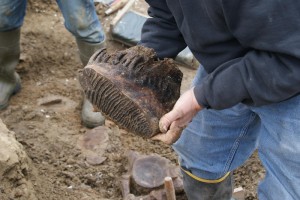Mahaska Mammoth Dig Ends For The Season

This mammoth tooth, massive in size, was carefully removed from its resting spot on Sunday afternoon. (photo by Don Hubbard)
Oskaloosa, Iowa – Moving the Earth one spoonful at a time might best describe the huge task scientists and volunteers have done during the past year while excavating the Mahaska Mammoth site.
The at least two confirmed mammoths are joined by bison in the plunge pool that has preserved them for the ages.
As I watched the landowner and a volunteer work on extracting the mammoth tooth on Sunday, the irony of the whole scene struck me. From that tooth, and the tusk, scientists will be able to tell many aspects of a mammoths life. How many times was it pregnant, if it was a female? How many years was there plenty to eat, and how many was there not so much?
But here, laying in the dirt, was these two individuals, scraping out the sediments that had filled in around this massive tooth with nothing more complex than a broken stick and a gloved hand. While back at the university, some of the best technology possible awaits their turn.
Sunday ended the dig for the season, after the discovery of 19 more bones and fragments. Researchers returned on Sunday with fresh burlap and plaster to help in the extraction and preservation of these bones. “This is the last little stack [of bones],” said Dave Brenzel of the Indian Creek Nature Center.
These bones, located in a drier portion of the dig, are more fragile than the previous ones.
During the summer months, volunteers and scientists had concentrated on the wetter portion of the ‘plunge pool’ where the bones had collected. Because of their location and the always present water, the bones and material were better preserved and could be lifted gently from their location in the blue clay. Researchers will return to that area next spring.
These new bones, in the drier section, have been exposed to oxygen and therefore have degraded to some extent. But with the careful work, like that being used to extract the tooth from the Earth, they will ultimately be saved.
“I think we’ve probably decided that that plunge pool that we imagined, small little plunge pool, added by the ’93 flood and all, that’s nothing compared to the plunge pool that was here when there was two major rivers here,” explains Brenzel.
Brenzel motions in a much bigger circle, “I think what you’re seeing is a plunge pool.” He’s now saying the location where the bones collected may be much larger than initially thought, and the possibilities of all the more to discover is exciting to everyone.
I asked Brenzel if the pool could be even larger than what is currently dug out. “Yeah, we haven’t even found the edge yet,” Brenzel said. “It’s clearly been all swirled around, dumped and broken,” Brenzel says of the deposit of bones.
At least two mammoth are confirmed on the site. Some bison bones have been discovered at the site as well, but no other Ice Age animals have been confirmed at the site as of yet. Those at the site on Sunday joke that the landowner is looking for a Saber-tooth, and everyone enjoys a chuckle, including the landowner.
The new tooth may hold even more of the story about the mammoth in Iowa. “That tooth will be diagnostic,” Brenzel explained. He went on further to explain that because the tooth enables researchers to do so many tests.
The tooth pulled from the ground on Sunday weighed approximately 20 pounds and is almost the size of a human head.
So for now, dirt once again will rest over the Mahaska Mammoth site, protecting its secrets from the blowing snow and winter elements one more time.
To see more photos from Sunday’s dig, click HERE.















